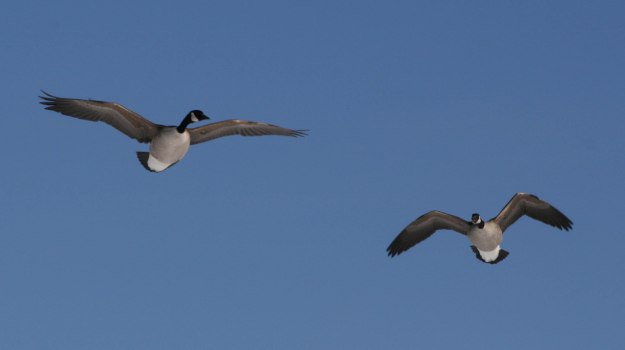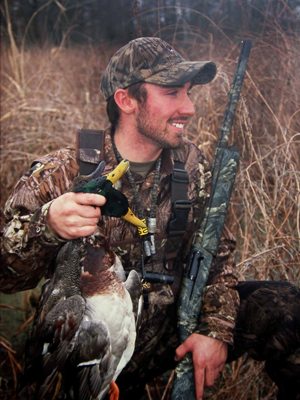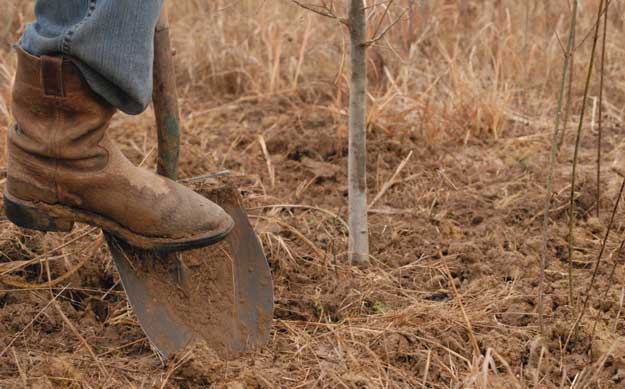
The most decoys I've ever put out in a spread were 50 dozen, large goose decoys. But to put that many decoys out before shooting time, we had to get to the field by 2:30 or 3 a.m. On that hunt, we were in about 1 to 1-1/2 feet of snow. We had about eight hunters all in layout blinds, and we all limited out on that day.
I'm often asked, “How do you get permission to hunt those big agricultural fields in Missouri?” The answer is really simple. I own an excavation company. So, I work with landowners every day. I understand the problems that they have with waterfowl hunters, and I've learned how to solve the problems that cause landowners not to let watermen hunt on their properties. Over the years, I've learned that if you get to know the landowners, learn their concerns and offer to come up with solutions to their problems, oftentimes, you can get permission to hunt where other hunters can’t hunt. My friends and I also respect their lands, and leave as little evidence of having hunted there as we possibly can.
 Another reason that we've had to depend more and more on private lands for taking waterfowl is that public waterfowl-hunting lands in the last 3-4 years have become more and more crowded. Once, we might have had 12 parties of waterfowl hunters on public lands where we hunted all trying to hunt ducks on weekends. Today, 50 parties of waterfowl hunters may be on that same public land that we once hunted.
Another reason that we've had to depend more and more on private lands for taking waterfowl is that public waterfowl-hunting lands in the last 3-4 years have become more and more crowded. Once, we might have had 12 parties of waterfowl hunters on public lands where we hunted all trying to hunt ducks on weekends. Today, 50 parties of waterfowl hunters may be on that same public land that we once hunted.
Editor’s Note: If you’ll notice, one of the key ingredients that Bob Matthys uses and has used to get access to prime waterfowl private property is that he knows and works with the landowner all year long. One of the problems that many hunters have is that they want to take shortcuts to getting private land not only to waterfowl hunt on, but to hunt any game species.
Plenty of private property may be available to you and your friends to hunt either for free or nearly free, if you understand these secrets to get prime private land hunting property.
- Begin to drive, and scout lands where you’ve seen an abundance of wildlife as soon as hunting season is over. Ducks and geese will show you the way to the private lands they prefer.
- Get a map from MyTopo of the property where you see the most waterfowl flying to, once you know where the ducks and geese are headed. The map, will show land boundaries and the names of the landowners.
- Go meet the landowner, and find out what type problem he may be having on his land that you can solve, after the season is over.
- Get to know the landowner and his family. Work with him to solve problems, and prove to him that you're not like the other hunters that he hasn’t given permission to hunt his land.
- Develop a working relationship with that landowner during the off-season. Help him solve whatever problems he has. Hopefully, he will at least give you a few days of waterfowl hunting, so he can see how you treat his property and his wildlife during waterfowl season. Once, the landowner realizes that you're an ethical hunter who respects his land and his wildlife, and you become a valued friend who helps him solve his problems, then you may be able to develop a long-term relationship and access to some outstanding waterfowl property that no one else can get permission to hunt.
This system is not an instant road to success. But if gaining access to private property for hunting waterfowl was easy, someone else would have gotten that opportunity. You may gain access not only to that landowner’s property, but the landowner may refer you also to other landowners who have an abundance of waterfowl on their lands.
Day 3: Learning that Necessity Is the Father of Invention for Duck and Goose Hunters




























